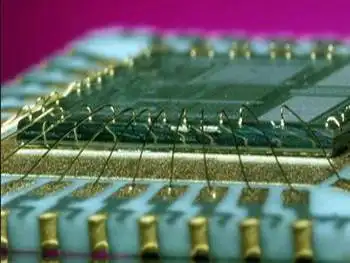In the field of semiconductor packaging and printed circuit board (PCB) manufacturing, wire bonding equipment, also known as wire bonders, plays a vital role. This equipment uses extremely fine metal wires, such as gold wires or aluminum wires, to accurately connect the chip's bonding pads to the package substrate or pins, achieving precise interconnection between the chip and the external circuit, ensuring efficient transmission of electrical signals and power.
Working Principle and Process
The wire bonding process mainly includes two key steps: first, ball formation, which uses a tiny electric soldering iron to heat the metal wire end to form a spherical structure as the starting point for subsequent welding; followed by the welding process, which uses heat and pressure (sometimes including ultrasonic energy) to firmly connect the metal wire between the chip pad and the package pin to ensure that the two can form a solid metallurgical bond. This process requires extremely high precision and reliability to ensure the stability and long-term performance of the electrical connection.

Technology Type and Equipment Features
Wire Bonder equipment can be divided into many types according to its different welding methods, including hot pressure welding, ultrasonic welding, and thermal ultrasonic welding.
Hot compression welding: The operation is simple, but the welding accuracy is relatively low, and it is more suitable for processing thicker metal wires.
Ultrasonic welding: It can provide high-precision welding results, but the cost is high, and the equipment performance and operation requirements are relatively strict.
Hot ultrasonic welding: It attempts to combine the advantages of hot compression welding and ultrasonic welding, but the process control is relatively complex and requires more sophisticated adjustment and preparation.
In terms of equipment characteristics, modern wire bonding equipment is usually equipped with programmable linear axes and carriers to achieve high-precision positioning and movement. In addition, these devices also usually use digitally controlled heating fixtures to adapt to the welding needs of different sizes and materials.
Market Application and Current Situation
In the field of PCB manufacturing and semiconductor packaging, wire bonding equipment is widely used to achieve electrical connections between chips and external circuits. With the continuous development of emerging technologies such as 5G communications, cloud computing, artificial intelligence and the Internet of Things, PCB products are constantly evolving towards high interconnection density integration and the trend of "short, small, light and thin", which puts higher requirements on the performance and stability of Wire Bonding equipment.
From the current market situation, the global PCB special equipment market continues to grow, especially in Asia, such as mainland China and Taiwan, China, where the proportion of PCB output value in the world remains at a high level, which has promoted the development of the PCB special equipment market. According to statistics, the global PCB special equipment market size in 2023 is about 6.79 billion US dollars, and it is expected to reach 8.78 billion US dollars by 2029. Against this background, as an important part of PCB special equipment, the market demand for wire bonding equipment has also shown a steady growth trend.
Future development trend
In the future, PCB wire bonding equipment will develop in a more precise, efficient and intelligent direction. On the one hand, with the growth of demand for fine wire diameter and smaller pitch welding, the process needs to be further optimized to adapt to advanced packaging technologies such as Fan-out and 3D packaging. On the other hand, by integrating artificial intelligence technology, continuously optimizing welding parameters and realizing real-time process monitoring, the defect rate will be effectively reduced and production efficiency will be improved.
In addition, material innovation is also one of the important directions for the development of wire bonding equipment in the future. For example, research and apply new welding materials, such as copper wire instead of gold wire, to achieve cost savings and environmental protection goals. At the same time, promoting the integration of Wire Bonder with other packaging equipment such as dicing machines and placement machines will also improve overall production efficiency and reduce production costs.
As one of the key equipment in the field of semiconductor packaging and PCB manufacturing, the stability and reliability of the performance of PCB wire bonding equipment directly determine the quality and cost-effectiveness of the product. With the continuous development of science and technology, wire bonding equipment will continue to upgrade and optimize to meet the needs of more precise, efficient and intelligent production. For packaging and testing engineers, mastering the latest developments in wire bonding technology means taking the lead in process optimization, cost control and technological innovation. Each tiny welding line is a link connecting future technology, driving the continuous advancement of semiconductor packaging and PCB manufacturing technology.